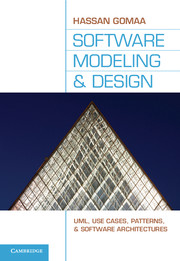Book contents
- Frontmatter
- Contents
- Preface
- Annotated Table of Contents
- Acknowledgments
- PART I Overview
- PART II Software Modeling
- 6 Use Case Modeling
- 7 Static Modeling
- 8 Object and Class Structuring
- 9 Dynamic Interaction Modeling
- 10 Finite State Machines
- 11 State-Dependent Dynamic Interaction Modeling
- PART III Architectural Design
- PART IV Case Studies
- Appendix A Catalog of Software Architectural Patterns
- Appendix B Teaching Considerations
- Glossary
- Answers to Exercises
- Bibliography
- Index
11 - State-Dependent Dynamic Interaction Modeling
from PART II - Software Modeling
Published online by Cambridge University Press: 05 June 2012
- Frontmatter
- Contents
- Preface
- Annotated Table of Contents
- Acknowledgments
- PART I Overview
- PART II Software Modeling
- 6 Use Case Modeling
- 7 Static Modeling
- 8 Object and Class Structuring
- 9 Dynamic Interaction Modeling
- 10 Finite State Machines
- 11 State-Dependent Dynamic Interaction Modeling
- PART III Architectural Design
- PART IV Case Studies
- Appendix A Catalog of Software Architectural Patterns
- Appendix B Teaching Considerations
- Glossary
- Answers to Exercises
- Bibliography
- Index
Summary
State-dependent dynamic interaction modeling deals with situations in which object interactions are state-dependent. State-dependent interactions involve at least one state-dependent control object that, by executing a statechart (as described in Chapter 10), provides the overall control and sequencing of its interactions with other objects.
Chapter 9 describes basic dynamic interaction modeling, which is stateless and, hence, does not involve any state-dependent interactions. During object structuring, the objects that participate in the realization of a use case are determined. If at least one of the objects is a state-dependent control object, then the interaction is defined as state-dependent and the term state-dependent dynamic interaction modeling should be used, as described in this chapter. State-dependent dynamic interaction modeling is a strategy to help determine how objects interact with each other in dynamic interactions involving at least one state-dependent control object. In more complex interactions, it is possible to have more than one state-dependent control object. Each state-dependent control object is defined by means of a statechart.
Section 11.1 describes the steps in state-dependent dynamic interaction modeling. Section 11.2 describes how to model interaction scenarios on interaction (both communication and sequence) diagrams and statecharts. Section 11.3 gives a detailed example of state-dependent dynamic interaction modeling from the Banking System.
- Type
- Chapter
- Information
- Software Modeling and DesignUML, Use Cases, Patterns, and Software Architectures, pp. 177 - 190Publisher: Cambridge University PressPrint publication year: 2011



